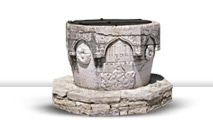
- Gradišće – Koper
- Podpeč – Zanigrad – Hrastovlje
- Slum – Roč – Hum
- Draguć – Paz – Gradinje – Gologorica
- Pićan – Gračišće – Lindar
- Pazin – Beram
- Oprtalj – Čirkoti – Rakotule
- Vižinada – Božje polje – Labinci
- Višnjan – Bačva – Poreč
- Sv. Lovreč – Kloštar
- Šorići – Dvigrad – Kanfanar
- Žminj – Svetvinčenat
- Bale – Batvači – Fažana – Pomer
- Bičići – Barban – Prodol
- Jasenovik – Nova Vas – Vranja
- Plomin – Brseč – Lovran
Sv. Lovreč – Kloštar
Kloštar
St. Michael
According to legend, the monastery of St. Michael was founded by St. Romuald, founder of the Camaldolese order, who had previously lived as a hermit in the nearby cave in Lim Channel. Be sure to visit this geological phenomenon and only Istrian fjord, as well as St. Romuald’s Cave.
Of the one-time mighty St. Michael’s Abbey which was in conflict with the Poreč bishops, only an abandoned and dilapidated monastery with two churches remains. The smaller one is an Early Byzantine edifice, and the larger one is St. Michael’s Church the church of the titular dating from the 11th c. In the sanctuary is a high, semi-circular apse. On the side wall, high above the roofing, original transennae with interlacing pattern have been preserved. St. Michael’s Church holds the remains of Romanesque frescoes. The trial and stoning of St. Stephen are the only scenes that can be interpreted in the apse and present the oldest scene of St. Stephen’s Martyrdom in Istria. The best preserved image is the saint on the right side of the triumphal arch. The image of a tonsured young saint with a crosier depicts a Benedictine saint, presumably the image of St. Romuald. Both human figures and architecture are presented stylized and summarily. The shapes of figures are defined by outlines of light and dark colors, and characteristic red spots on the cheeks. Both the iconographic and artistic models are diverse, ranging from Carolingian ornamental elements to Hellenistic-Oriental motifs in clothing. The royal crown is of a Carolingian type, resembling those worn by German kings. All the mentioned elements are characteristic features of the international Benedictine monastic painting of the Ottonian period.
Print page Send to a friend


















